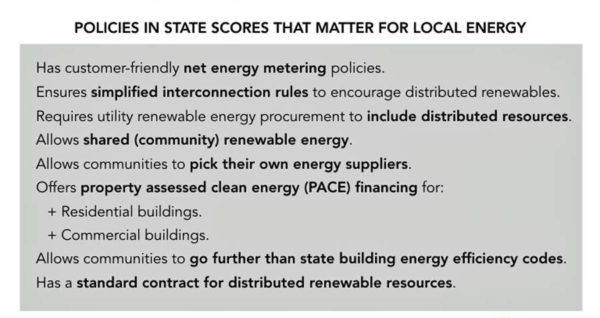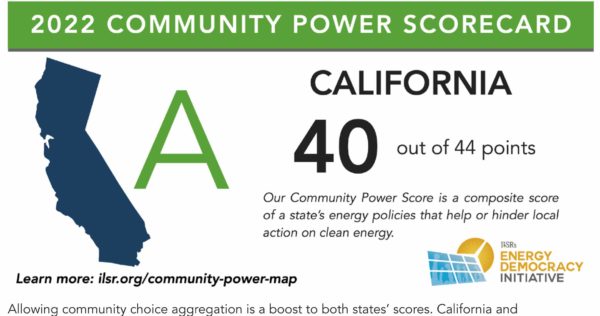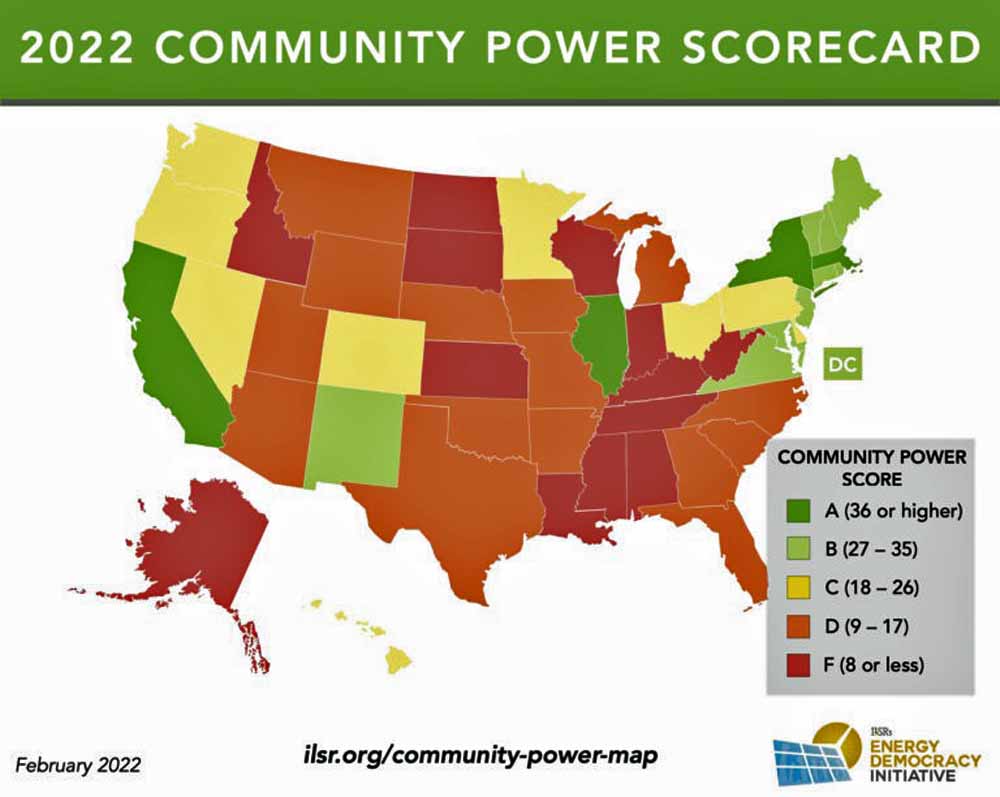According to the Community Power Scorecard, released by the Institute for Local Self-Reliance (ILSR), four states lead the country in renewable energy policies: California, Massachusetts, New York, and Illinois.
The 2022 edition of the Community Power Scorecard grades each state on whether its energy policies give individuals, cities, and communities the choice to build clean energy wealth locally, rather than relying on utilities. The scoring is based on a compilation of data from the American Council for an Energy-Efficient Economy, DSIRE, the National Renewable Energy Laboratory, PACENation, SolarReviews, and Vote Solar, as well as the data the ILSR tracks on community solar, community choice aggregation, and state legislative changes in general.

State policies that contributed to higher scores include customer-friendly net-metering policies, interconnection rules that encourage distributed renewable energy, allowing for community choice in energy sources, letting communities set energy efficiency codes, and the ability for cities to negotiate utility franchise contracts and fees.
In the 2022 Community Power Scorecard, 4 states excelled, 9 states and the District of Columbia saw above average scores, 9 were average, 15 were mediocre, and 13 states received failing grades.
“Many cities have ambitious climate or community resilience goals, but their path forward is limited by state policy. When states remove barriers and provide innovative policy options, communities can make decisions that maximize local benefits in the transition to clean energy,” said Maria McCoy, ILSR Research Associate and lead author of the Community Power Scorecard.
How the top four earned the grade
California and Massachusetts both got an A, scoring 40 out of 44 points. Both states support community-choice aggregation, community solar, solar/storage mandates, third party financing, and net metering (although California’s net metering policy is in peril). California also allows cities to start PACE financing programs and set more stringent building codes.

New York also received an A, with a score of 38 out of 44 points. New York enables community choice aggregation and has a community solar program.
Illinois received an A, with a score of 37 out of 44. The Climate and Equitable Jobs Act (CEJA) boosted Illinois’s grade to an A this year, and CEJA
established a stretch building energy code for cities to adopt.
Who failed?
Louisiana, Kentucky, Idaho, and South Dakota all received a grade of F. Louisiana scored only one point out of 44, finishing last, again. (It has been last or tied for last since 2019.) Kentucky scored three points total. In 2021, state legislators passed a bill that will undercut net metering: solar generation will not offset energy use and is compensated at a sub-retail rate. Idaho scored one point higher than Kentucky because it has an acceptable net metering policy and it preempts communities from banning gas hookups. South Dakota received four points–a bit better than Louisiana and Kentucky because it doesn’t lose points for poor interconnection standards or preempting gas bans.
Along with a comprehensive ranking of all 50 states, the Community Power Scorecard highlights state leaders in 9 geographic regions of the country.
This content is protected by copyright and may not be reused. If you want to cooperate with us and would like to reuse some of our content, please contact: editors@pv-magazine.com.









By submitting this form you agree to pv magazine using your data for the purposes of publishing your comment.
Your personal data will only be disclosed or otherwise transmitted to third parties for the purposes of spam filtering or if this is necessary for technical maintenance of the website. Any other transfer to third parties will not take place unless this is justified on the basis of applicable data protection regulations or if pv magazine is legally obliged to do so.
You may revoke this consent at any time with effect for the future, in which case your personal data will be deleted immediately. Otherwise, your data will be deleted if pv magazine has processed your request or the purpose of data storage is fulfilled.
Further information on data privacy can be found in our Data Protection Policy.